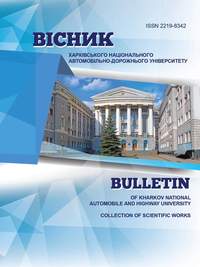Application of modern lithium – ionic battery packages on electric cars
DOI:
https://doi.org/10.30977/VEIT.2018.13.0.28Abstract
Problem. In connection with the increase in efficiency and environmental safety of cars, electric vehicles and hybrid cars were introduced into mass production. In the world, their number is growing every year. In Ukraine, the hybrid car Toyota Prius is used by the patrol police of Ukraine, and Nissan Leaf electric cars are widely introduced into the taxi network. For the owners of these cars, it is important to understand the features of their technical service, diagnosis and maintenance. Purpose. The aim of the work is to study the basic structures and modifications of lithium-ion batteries and to determine the rules for the technical operation of these batteries on hybrid and electric cars. Methodology. The design features of lithium-ion batteries and their varieties, which have received practical development on the example of two main types of batteries - with cylindrical and packet cells, which are used on electric vehicles from leading companies Tesla and Nissan, are analyzed. Results. The limiting technical (diagnostic) parameters that determine the operating rules for lithium-ion batteries on electric vehicles are highlighted: this is the maximum voltage on the battery element 4.30 V, the maximum heating temperature of the battery cell to 90 ° С, the threshold pressure level inside Cases 1034 kPa (10.5 kg / m2), the minimum voltage on the battery cell is 2.5 V. Originality. Through an analysis of the design features and diagnostic parameters of Li-Ion batteries, the rules of technical operation and recommendations for increasing the service life of these batteries on hybrid and electric cars in Uraine are considered. Practical value. The results of the research allow us to make certain recommendations for increasing the service life of lithium-ion batteries on hybrid and electric cars when used in Ukraine.
Keywords:
lithium-ion battery; electric vehicle; hybrid; diagnostics; malfunction; operation; service life.
References
Litiy-ionnyye akkumulyatory. [Lithium-ion batteries]. Retrived from: http://www.powerinfo.ru/accumulator-liion.php (accessed: 2.08.2018) [in Russian]
Obzor batarei Nissan Leaf. [Battery review Nissan Leaf]. Retrived from: http://ecotechnica.com.ua/stati/966-ustrojstvo-batarej-nissan-leaf-tesla-model-s-i-chevy-bolt-chej-akkumulyator-luchshe.html (accessed: 2.08.2018) [in Russian]
Akkumulyatornaya batareya elektrokara Tesla Model S. [Battery Electric Tesla Model S]. Retrived from: http://autotesla.ru/auto-tesla/akkumulyatory-tesla/akkumulyator-tesla-model-s-chto-vnutri-razbiraem.html (accessed: 20.08.2018) [in Russian]
Shirokun I. (2016) Analiz neispravnostey sovremennyih akkumulyatornyih batarey elektromobiley [Fault analysis of modern electric vehicle batteries]. «Avtotsentr», 2 [in Russian].
Pravila ekspluatatsii litiy–ionnykh batarey na elektromobilyakh. [Rules for the operation of lithium-ion batteries in electric vehicles]. Retrived from: http://rutesla.com/560/5-sovetov-kak-prodlit-vremya-zhizni-batarey-elektroavtomobiley/ (accessed: 20.08.2018) [in Russian]
Primeneniye litiyevykh batarey v gibridakh i elektromobilyakh. [The use of lithium batteries in hybrids and electric vehicles]. Retrived from: http://autoeco.info/libatt.php (accessed: 20.08.2018) [in Russian]
Elektromobil' Nissan Leaf. [Electric Nissan Leaf.]. Retrived from: https://ru.wikipedia.org/wiki/Nissan_LEAF (accessed: 20.08.2018) [in Russian]
Знаемский С. Обзор электромобиля Tesla Model S. «Авторевю». – 2015. – №12
Elektromobil' Tesla Model S. [Electric vehicle Tesla Model S]. Retrived from: https://en.wikipedia.org/wiki/TeslaModel S (accessed: 20.08.2018) [in Russian]
Hnatov A. V., Arhun Shch. V., Ulianets O. A. (2017). Elektromobili – maibutnie, yake vzhe nastalo [Electric cars - the future that has already come]. Avtomobyl y эlektronyka. Sovremennыe tekhnolohyy: эlektronnoe nauchnoe spetsyalyzyrovannoe yzdanye. Kharkiv: KhNADU, 11, 24–28 [in Ukrainian].
Hnatov A. V., Arhun Shch. V. (2017). Retrospektyva osnovnykh etapiv rozvytku elektromobiliv. Chastyna 2 [Retrospective of the main stages of the development of electric vehicles. Part 2] Kharkiv: Visnyk KhNADU, 78, 116–124 [in Ukrainian].
Hnatov A. V., Arhun Shch. V. (2017). Retrospektyva osnovnykh etapiv rozvytku elektromobiliv. Chastyna 1 [Retrospective of the main stages of the development of electric vehicles. Part 2] Kharkiv: Visnyk KhNADU, 77, 68–74 [in Ukrainian].
Sub'ektivnyy vzglyad na dostupnyy sovremennyy elektromobil'. [Subjective view of the affordable modern electric car]. Retrived from: http://dig.by/book/export/html/129 (accessed: 20.08.2018) [in Russian].
Пристатейна бібліографія ДСТУ
Литий-ионные (Li-ion) аккумуляторы [электронный ресурс]: Режим доступа: http://www.powerinfo.ru/accumulator-liion.php
Обзор батареи Nissan Leaf[электронный ресурс]: Режим доступа:http://ecotechnica.com.ua/stati/966-ustrojstvo-batarej-nissan-leaf-tesla-model-s-i-chevy-bolt-chej-akkumulyator-luchshe.html
Аккумуляторная батарея электрокара Tesla Model S[электронный ресурс]: Режим доступа:http://autotesla.ru/auto-tesla/akkumulyatory-tesla/akkumulyator-tesla-model-s-chto-vnutri-razbiraem.html
Анализ неисправностей современных аккумуляторных батарей электромобилей / И. Широкун // «Автоцентр» – 2016 – №2.
Правила эксплуатации литий–ионных батарей на электромобилях[электронный ресурс]: Режим доступа:http://rutesla.com/560/5-sovetov-kak-prodlit-vremya-zhizni-batarey-elektroavtomobiley/
Применение литьевых батарей в гибридах и электромобилях[электронный ресурс]: Режим доступа:http://autoeco.info/libatt.php
Электромобиль Nissan Leaf [электронный ресурс]: Режим досту-па:https://ru.wikipedia.org/wiki/Nissan_LEAF
Обзор батареи Nissan Leaf[электронный ресурс]: Режим досту-па:http://ecotechnica.com.ua/stati/966-ustrojstvo-batarej-nissan-leaf-tesla-model-s-i-chevy-bolt-chej-akkumulyator-luchshe.html
Обзор электромобиля Tesla Model S/ С. Знаемский// «Авторевю»–2015–№12.
Электромобиль Tesla Model S[электронный ресурс]: Режим доступа:https://en.wikipedia.org/wiki/TeslaModel S.
Downloads
Published
How to Cite
Issue
Section
License
Copyright (c) 2021 Ирина Юрьевна Сараева, Андрей Анатольевич Стародубцов

This work is licensed under a Creative Commons Attribution 4.0 International License.
Автори, які публікуються у цьому журналі, погоджуються з наступними умовами:
1. Автори залишають за собою право на авторство своєї роботи та передають журналу право першої публікації цієї роботи на умовах ліцензії Creative Commons Attribution License, котра дозволяє іншим особам вільно розповсюджувати опубліковану роботу з обов'язковим посиланням на авторів оригінальної роботи та першу публікацію роботи у цьому журналі.
2. Автори мають право укладати самостійні додаткові угоди щодо неексклюзивного розповсюдження роботи у тому вигляді, в якому вона була опублікована цим журналом (наприклад, розміщувати роботу в електронному сховищі установи або публікувати у складі монографії), за умови збереження посилання на першу публікацію роботи у цьому журналі.
3. Політика журналу дозволяє і заохочує розміщення авторами в мережі Інтернет (наприклад, у сховищах установ або на особистих веб-сайтах) рукопису роботи, як до подання цього рукопису до редакції, так і під час його редакційного опрацювання, оскільки це сприяє виникненню продуктивної наукової дискусії та позитивно позначається на оперативності та динаміці цитування опублікованої роботи.








